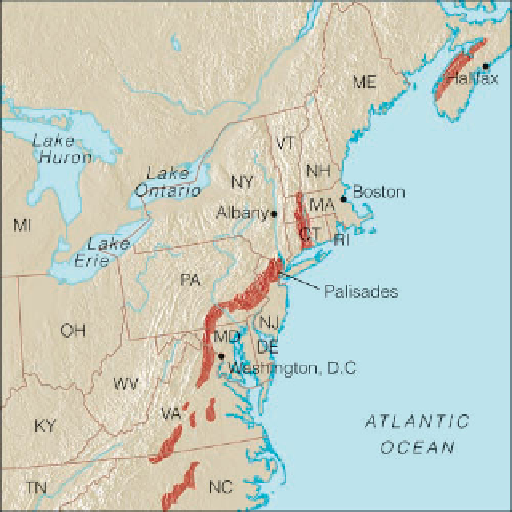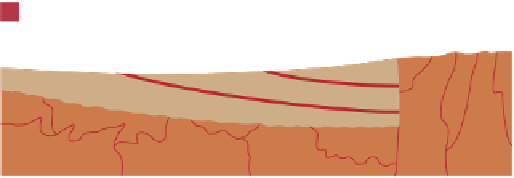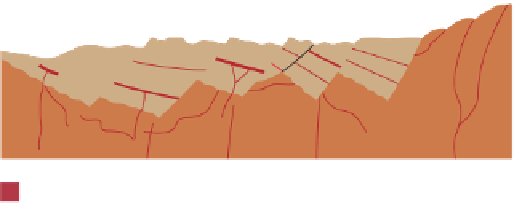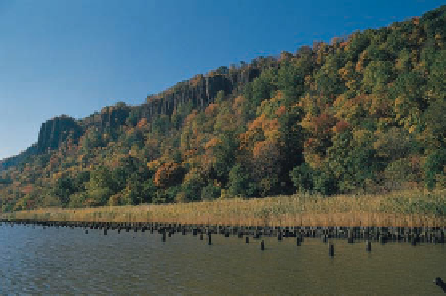Geology Reference
In-Depth Information
?
◗
Figure 22.7
North American Triassic Fault-Block Basins
What Would You Do
Because of political events in the Middle East, the oil-producing
nations of this region have reduced the amount of petroleum
that they export, resulting in shortages in the United States.
To alleviate U.S. dependence on overseas oil, the major oil
companies want Congress to let them explore for oil in many
of our national parks. As director of the National Park system,
you have been called to testify at the congressional hearing
addressing this possibility. What arguments would you use to
discourage such exploration? Would a knowledge of the geol-
ogy of the area be helpful in your testimony? Explain.
huge batholiths that are now recognized as the Sierra Ne-
vada, Southern California, Idaho, and Coast Range batholiths
(
Figure 22.12). It was also during this time that the Fran-
ciscan Complex and Great Valley Group were being depos-
ited and deformed as part of the Nevadan orogeny within
the Cordilleran mobile belt.
By the Late Cretaceous, most of the volcanic and plu-
tonic activity had migrated eastward into Nevada and Idaho.
This migration was probably caused by a change from high-
angle to low-angle subduction, resulting in the subduct-
ing oceanic plate reaching its melting depth farther east
(
◗
a
Areas where Triassic fault-block basin deposits crop out in
eastern North America.
Figure 22.13). Thrusting occurred progressively farther
east, so that by the Late Cretaceous, it extended all the way to
the Idaho-Washington border.
The second phase of the Cordilleran orogeny, the
Sevier
orogeny,
was mostly a Cretaceous event even though it began
in the Late Jurassic and is associated with the tectonic activity
of the earlier Nevadan orogeny (Figure 22.11). Subduction of
the Farallon plate beneath the North American plate contin-
ued during this time, resulting in numerous overlapping, low-
angle thrust faults in which blocks of older strata were thrust
eastward on top of younger strata (
◗
b
After the Appalachians were eroded to a low-lying plain by the
Middle Triassic, fault-block basins such as this one (shown in cross
section) formed as a result of Late Triassic rifting between North
America and Africa.
(b)
Figure 22.14). This defor-
mation produced generally north-south-trending mountain
ranges that stretch from Montana to western Canada.
During the Late Cretaceous to Early Cenozoic, the fi nal
pulse of the Cordilleran orogeny took place (Figure 22.11).
The
Laramide orogeny
developed east of the Sevier oro-
genic belt in the present-day Rocky Mountain areas of New
Mexico, Colorado, and Wyoming. Most features of the
present-day Rocky Mountains resulted from the Cenozoic
phase of the Laramide orogeny, and for that reason, it will be
discussed in Chapter 23.
◗
c
These valleys accumulated tremendous thicknesses of sediments
and were themselves broken by a complex of normal faults during rifting.
Mesozoic Sedimentation
Concurrent with the tectonism
in the Cordilleran mobile belt, Early Triassic sedimentation
on the western continental shelf consisted of shallow-water
marine sandstones, shales, and limestones. During the Mid-
dle and Late Triassic, the western shallow seas regressed far-
ther west, exposing large areas of former seafl oor to erosion.
Marginal marine and nonmarine Triassic rocks, particularly
red beds, contribute to the spectacular and colorful scenery
of the region.
d
Palisades of the Hudson River. This sill was one of many
intruded into the Newark sediments during the Late Triassic rifting
that marked the separation of North America from Africa.

















Search WWH ::

Custom Search